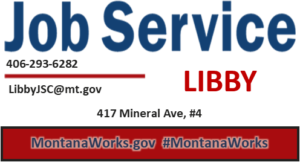Sunrise & Sunset Times
| Date | Sunrise | Sunset |
| June 9 | 5:40:52 a.m. | 9:42:37 p.m. |
| June 10 | 5:40:39 a.m. | 9:43:15 p.m. |
| June 11 | 5:40:28 a.m. | 9:43:51 p.m. |
| June 12 | 5:40:20 a.m. | 9:44:24 p.m. |
| June 13 | 5:40:15 a.m. | 9:44:55 p.m. |
| June 14 | 5:40:12 a.m. | 9:45:23 p.m. |
| June 15 | 5:40:12 am. | 9:45:49 p.m. |
Simons Weekly Weather
Northwest Montana Regional Forecast
Includes Lincoln
and Sanders Counties
Libby, Troy,
Eureka, Yaak,
Bull Lake, Noxon,
Heron, Trout Creek,
Thompson Falls, and
The Cabinet Mountains
Tuesday, June 8—
Considerable cloudiness and a little warmer.
Highs in the 70s with
mid 50s around 5000 feet. Light winds.
Wednesday & Thursday, June 9 & 10—
A chance of rain and high elevation snow. Lows in the 40s with upper 30s around 5000 feet. Highs
in the 60s with mid 40s around 5000 feet.
Friday & Saturday,
June 11 & 12—
Dry and warmer. Lows
in the mid 30s to mid 40s with lower 40s around 5000 feet. Highs in
the lower 70s to lower 80s with upper 50s around 5000 feet.
Sunday, June 13—
A chance of rain. Lows in the mid 40s to lower 50s with mid 40s around 5000 feet. Highs in
the mid 60s to mid 70s with lower 50s around 5000 feet.
For the most up to
date information visit
www.simonsweather.org
Simon on Facebook:
facebook.com/
Montana Gas Price
As of June 7, 2021 –
Montana gas prices have risen 0.9 cents per gallon in
the past week, averaging $2.95/g today, according to GasBuddy’s daily survey of 615 stations in Montana.
Gas prices in Montana are 9.5 cents per gallon higher than a month ago and stand $1.02/g higher than a
year ago.
Courtesy of GasBuddy
NATIONAL KITCHEN KLUTZES
—OF AMERICA DAY—
IT’S YOUR DAY!
June 13th honors those who would like to cook and be in the kitchen, but it just doesn’t seem to work well for them.
Kitchen Klutzes are the people who set out with the intentions of being like Gordon Ramsey or Julia Child as they open up the cookbook. As they place the mixing bowl and ingredients on the counter, they imagine knife cuts as swift as Wolfgang Puck or Bobby Flay. However, reality quickly dissolves all those dreams as smoke billows from the oven, and they mistake salt for sugar. Those knife cuts turn bloody, and cookies and fingers are burnt.
It may be necessary to keep a first aid kit and fire extinguisher handy when Kitchen Klutzes are around. Be ready to call 911 and have your favorite take out ready as backup if you’re still hungry.
HOW TO OBSERVE #NationalKitchenKlutzesDay
– Laugh at yourself. Share your mortifying stories of kitchen failure over take out Thai or pizza.
– Give your favorite Kitchen Klutz the gift of cooking classes.
Don’t forget to share your stories and celebrations using #NationalKitchenKlutzesDay on social media.
MSU Extension offers financial planning tool for monthly expenses
Submitted by MSU News
BOZEMAN — While some people find monthly bills easier to plan for and expect, non-monthly bills can be harder to keep track of. If not planned for properly, a bill that’s due every six months, such as auto insurance, may end up on a credit card or other form of payment.
To ease the burden for individuals who struggle with non-monthly bills, Montana State University Extension has a free financial planning MontGuide available to help with calculations.
“‘The Schedule of Non-monthly Family Living Expenses’ MontGuide will give you a clear picture of how your non-monthly payments are distributed throughout a 12-month period,” said Marsha Goetting, MSU Extension family economics specialist. “At a glance, you can see what bills are due in what months and plan ahead for them.”
The form will help individuals calculate how much to set aside each month so they can avoid the stress that arises when several major bills come due during the same month, Goetting said. The MontGuide contains a sample form and directions for filling it out. A blank form is also provided.
“The Schedule of Non-monthly Expenses”
MontGuide can be found at: store.msuextension.org/publications/FamilyFinancialManagement/MT198910HR.pdf. Users can go to the same site and click on the
worksheet to calculate their monthly and yearly averages. Paper copies are also available at local Extension and reservation offices.
Director Of Rehabilitation
– Occupational Therapist – PRN
– Home Care Aide/$10.50-$13.28/Full-Time
– Caregiver Libby and Troy /$10.50/Hours Vary
– Direct Service Staff/All Shifts/Achievements
– Management Position/Group Home Care/$14.00
– Delivery Driver / Sales/$9.00/Sears
– EMT
– Coordinator Nursing/FVCC
– Surgery RN/PRN
– Receptionist/Full-Time/CHC
– Casino Bookkeeper
– Crew Team Member
– Respiratory Therapist PRN
– Self-Pay Collector
– Food Service Worker-PRN
ATTENTION: Job Service Libby continues to require that all communications be handled through email at
LibbyJSC@mt.gov or phone (406) 293-6282.
Employers: Are you having a hard time filling
positions or training workers? Contact Job Service to learn about several programs that can assist you with the cost of hiring and training workers!
Job Seekers: Have you been laid off? Do you have
a current job offer? Plans to enter a job training
program? Job Service Libby may be able to help you
reach your career goal. Stop by our office, 417 Mineral Avenue, #4, and pick up a Career Exploration Assessment in the kiosk by the office door. Fill out, return to Job
Service, and a Career Coach will contact you.
*A full listing of all jobs now available in Lincoln County can be accessed by visiting Montana Works at
MontanaWorks.gov.
“With a forest of 2.2 million acres, if everyone can’t get at least some of what they need than something is terribly wrong…”
The board members of the Kootenai Forest Stakeholders Coalition (KFSC) feel obligated to speak up about the role of public input in public land management actions. The KFSC is a collaborative group dedicated to seeking common ground and finding good solutions to help guide public forest management.
Recently, after a long period of mostly respectful public discussion of forest management issues, we have seen some discussion of these issues that is reminiscent of the era of the timber wars, when conflict, disrespect and polarization were the norm.
One of the great things about our country is we are free to choose, we are free to express our opinions in a multitude of ways. At KFSC, it pains us to see abuse and disrespect returning to our community, and the degradation of the working relationships between the public and the agency.
We live in a great country, blessed with a bounty of natural resources and tremendous public land assets. We are fortunate to have professional, experienced and dedicated public land managers who work to steward these lands for the common good. We are also fortunate to have a process in place to share our thoughts, concerns, ideas and issues with those land managers known as the “public input process”.
The public input process is not a vote! It is not a popularity contest or campaign to try to bully a decision maker into doing what “you want done”. It IS an opportunity to voice your concerns, raise issues that need to be analyzed and considered by the decision maker. It is also an opportunity to help form the purpose and need for the project, as well an opportunity to learn from the land managers about the current conditions, the challenges, the desired future ecological and social conditions for the area.
We seem to be once again at a decision point. The people of Lincoln County can choose to engage in a productive and
respectful interaction on land management issues or we can retreat to our corners and sharpen our pens and tongues. We can
pursue accurate information, or we can
repeat exaggerated “facts”. The KFSC
encourages our community to recommit ourselves to respectful and open-minded dialogue.
The KFSC board includes members of the conservation community, timber industry, outdoor recreation enthusiasts, local elected officials and common citizens. We do not agree on every aspect of management on every acre of the forest. We often have different thoughts and opinions, but what we have found are many shared values. As co-chairman Tim Dougherty has stated time and again over 15+ years with the Stakeholders “with a forest of 2.2 million acres, if everyone can’t get at least some of what they need than something is terribly wrong”.
We encourage people to get involved in the management of their public lands, join our group if you desire or visit our website at www.kootenaifuture.org. But please do so with an open mind, respect for others and their values, and with
regard for the truth of what is actually proposed.
Submitted by:
Tim Dougherty,
KFSC Co-Chair
Doug Ferrell,
KFSC Co-Chair
Trout Creek, Mont.
The Montana Forest Action Plan
Current and potential climate changes are a concern to forest managers as they discern how best to maintain resilient forest conditions. In that regard, the Montana Forest Action Plan (MFAP) was developed in 2019 by an interdisciplinary advisory council, following the Forestry in Focus initiative authorized by Governor Bullock. Intending to be a cross boundary, collaborative approach to forest management, the MFAP is “the all lands, all hands plan for addressing forest health and wildfire risk issues across the state”. The Montana Department of Natural Resources and Conservation (DNRC) is the lead agency on this initiative which intends to assist land managers, and their partners, to further management by facilitating cooperation across land boundaries.
About 3.8 million acres of forest land has been identified in the MFAP as Priority for Focused Attention. Recommended strategies with this plan involve a diverse range of management actions. Any management decisions are intended to be made at the project level, by the collaborators involved, and consistent with area management plans.
The Rabbit Tracks project, an almost 30,000 acre area just north of Troy, is an example of a collaborative effort by public and private landowners to address Priority Areas for treatment. Located entirely in the WUI, the project intends to improve forest resilience to fire, insects, and disease; maintain old growth characteristics; reduce fuels; improve water quality; provide forage and security for wildlife; and support the wood products industry. Restoration activities will include tree and shrub planting, fuels treatments, pre-commercial and commercial timber harvest, prescribed burning, and weed treatments.
Governor Greg Gianforte recently announced the funding of 14 forest management projects across Montana that address the concerns identified in the MFAP. The state has committed $4.5 million for the new projects and has received $500,000 in grant funds from the USDA Forest Service. The Rabbit Tracks project was one of the projects approved for funding. Collaborating landowners include the Forest Service, Stimson Lumber Co., DNRC, Vital Ground Foundation, and private non-industrial landowners.
The condition of Montana’s forests has an effect on all of us, regardless of land ownership. By working to align the efforts of diverse partners across the state, we can advance a common mission of strengthening our shared stewardship of Montana’s forests and advancing practices that adapt to and potentially reduce the effects of climate change. The Kootenai Climate Group supports the objectives of the MFAP and considers fuels reduction in the WUI to be an effective tool in
promoting adaptation to climate change.
Submitted by:
Russ Gautreaux
for the Kootenai Climate Group
PO Box 421
Troy, MT 59935




